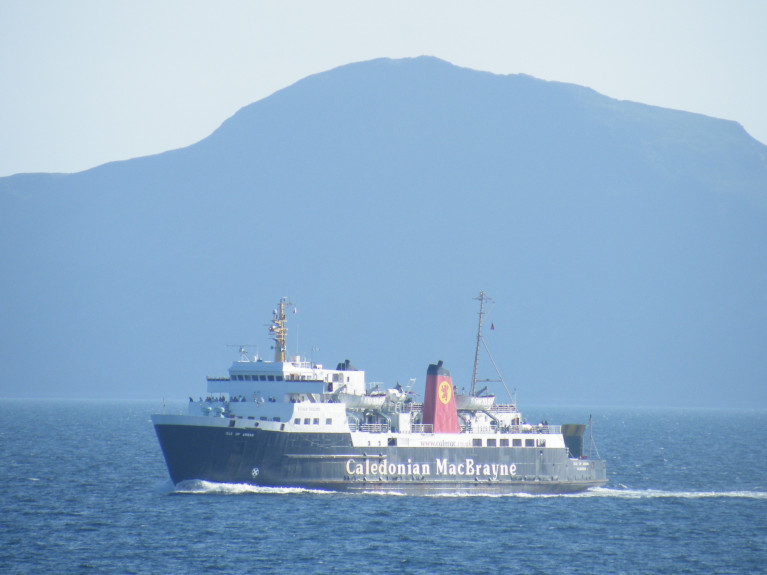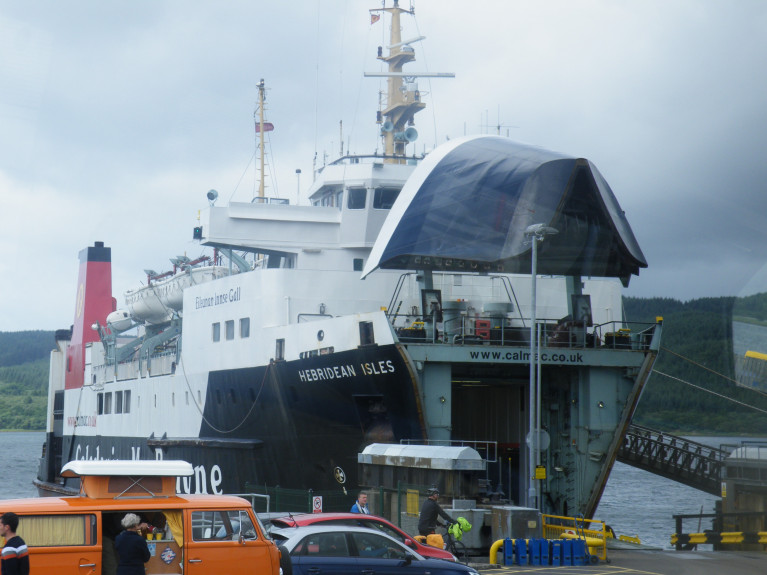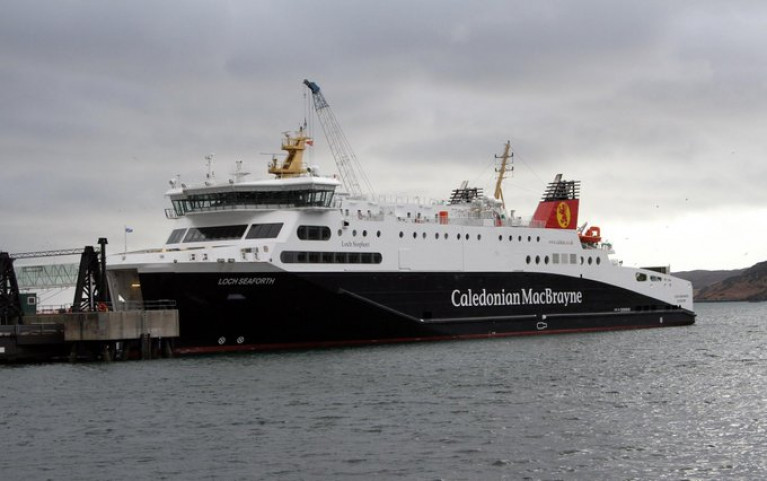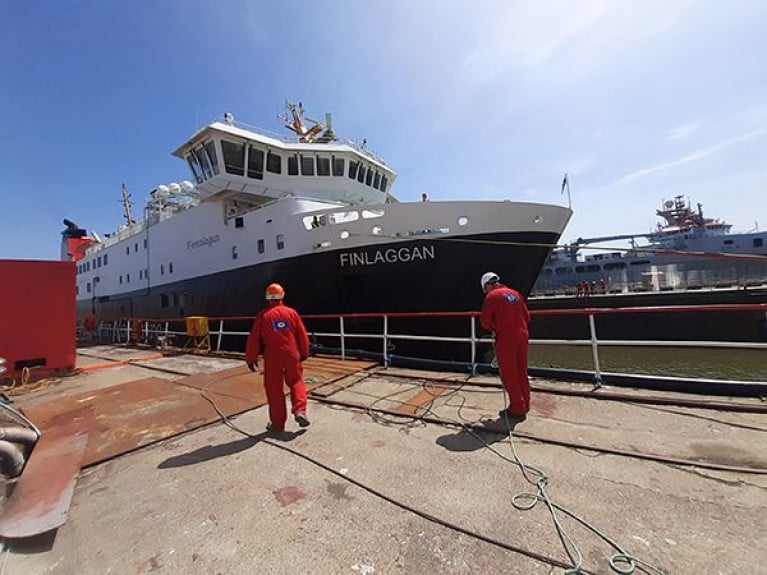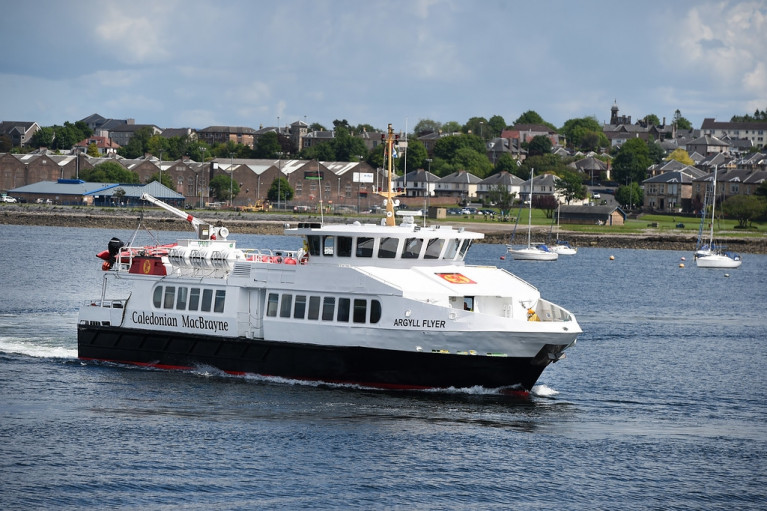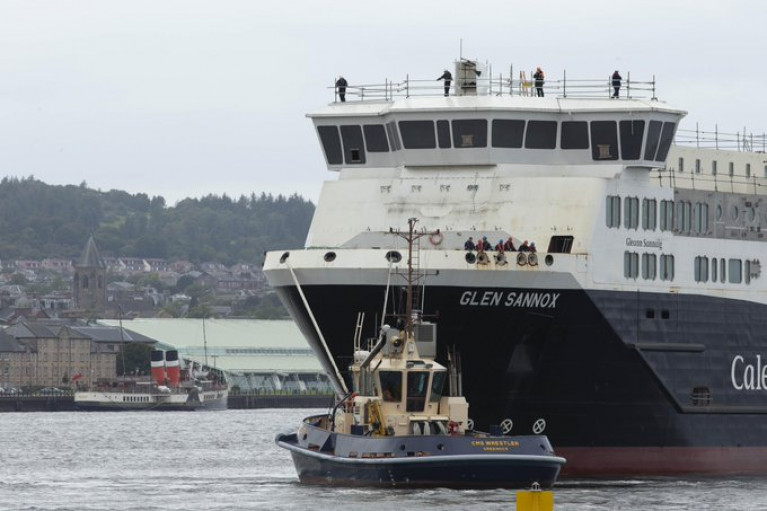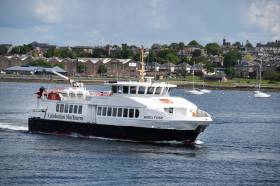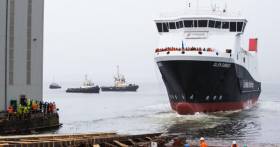Displaying items by tag: CalMac
Scottish Western Isles Ferry Fleet ‘Left to Rust’ as Cost of CalMac Repairs Spiral
Ferry operator CalMac which is owned by the Scottish Government, has been accused of leaving the fleet to rust, as new figures show the cost of repairs rising by almost a quarter.
Since the start of the current CalMac franchise in 2016, the cost of repairs and maintenance for the fleet has risen by 23 per cent to £17,262,000 for the year. The total cost of repairs over the last five years amounts to £83,661,000.
CalMac’s services comprise the UK’s largest ferry operation, with a network of 29 routes stretching from Stornoway to Campbeltown (see 'seasonal' Mull of Kintyre excursion story).
A number of the sharpest increases were for ships running well past their original 25-year lifespan. This includes a 70 per cent rise in costs for the 36 year-old MV Loch Striven over the last five years; a 61 per cent rise in the costs for the 37 year-old MV Isle of Arran over the last five years and a 73 per cent rise in costs for the 29 year-old MV Caledonian Isles over the last five years.
Some of the newer vessels are not faring much better, with costs for the beleaguered MV Loch Seaforth (see Irish Sea story) rising 45 per cent, despite it only being launched in 2014. Similarly, costs for the seven year-old MV Catriona have tripled, rising by 197 per cent.
Further reading from The Scotsman.
Proud Scottish Ferry Industry Buffeted by Failure
Vessels carrying passengers were once built to last, now under the Scottish National Party (SNP) they are not being built at all.
The operator at the heart of Scotland’s west coast ferry crisis, Caledonian MacBrayne (CalMac), has been around for much longer than most Scots realise.
Today’s CalMac can trace its roots back to the middle of the 19th century when the ship-owning brothers George and James Burns struck a succession deal.
They were the Burns of Burns & Laird Line, whose steamers linked ports such as Liverpool and Glasgow with Belfast right up to the 1970's.
But the deal George Burns did in 1851 was to secure the future of G & J Burns’s local coastal ferry services between Scotland’s western seaboard and its numerous island communities.
The brothers sold that Scottish arm of their business to David Hutcheson, the chief clerk.
The Times has more on the story.
CalMac's Biggest Ferry Finally Returns to Scotland's Western Isles after Weeks of Chaos
The biggest Scottish Western Isles ferry was due back in service (yesterday) after nearly seven weeks of for repairs on the Clyde as Afloat reported in April.
As the Herald writes, MV Loch Seaforth was taken off the Ullapool-Stornoway (Isle of Lewis) route by the state ferry operator, CalMac in mid-April and taken into dry dock for "major" engine repairs.
It led to persistent six delays in getting the ferry back in service as repairs continued.
Now Scottish Government-funded CalMac CalMac say sea trials on the MV Loch Seaforth have been successful and the ferry will return to service as planned. (Afloat today tracked the 700 passenger car ferry operating back on its routine route).
Following major repairs, the ferry departed the James Watt dock in Greenock on Friday and completed 50 hours of sea trials before arriving in Stornoway.
Further tests were carried out on Monday (yesterday) and they were also successful.
The newspaper has more details also on CalMac's southernmost routes, among them the Arran route and those to the Mull of Kintyre as Afloat previously reported.
Afloat also adds the 8,000 gross tonnage Glasgow registered ferry built, after making a delivery voyage to Scotland from the FSG Flensburg shipyard in 2014, surprisingly headed into the Irish Sea (off Wicklow Head) for further sea trials.
The German shipyard was also responsible for launching Seatruck's Irish Sea quartet of 'Heysham' max ro-ro freight ferries during 2011-2012.
In addition Irish Ferries cruiseferry W.B. Yeats launched by FSG in 2018, but did not enter service until early in the following year, firstly on the Irish Sea prior to making a debut on an Ireland-France link.
According to Merseyside shipyard Cammell Laird, demand for longer term repair and maintenance framework relationships from ferry operators is increasing as the sector prepares to recover from Covid.
Despite a reduction in ferry projects at the UK facility in Birkenhead, north-west England, during 2020 as many operators, particularly those involved in passenger traffic, delayed all but vital work – the market for wider maintenance and repairs is improving.
In particular, ferry operators are showing an appetite for longer term contracts and greater collaborative working with the supply chain, rather than dealing with routine repairs and maintenance on a purely annual or individual basis.
Neil Harden, Commercial Director at Cammell Laird Shiprepairers & Shipbuilders Limited said: “Although there was a reduction in ferry work during 2020 due to the pandemic, there is a growing movement away from short term thinking in favour of longer term solutions.
“Ferry operators are seeking greater certainty. That’s in relation to cost and vessel availability, but perhaps more importantly in the workings of these supplier relationships too. In our experience it is long-term collaborative partnerships that yields the in-depth knowledge of vessels that is so crucial to effective problem solving, maintaining the highest level of vessel availability and increasing programme efficiencies.”
This approach also affords Cammell Laird the opportunity to plan ahead – ensuring dock, equipment and resource availability and communicating with subcontractors well ahead of time.
In January, Cammell Laird secured a four-year contract with CalMac, one of the UK’s largest ferry operators, for the annual maintenance and dry docking of the five largest vessels in its fleet, using this model.
The contract from CalMac provides a long-term, collaborative and cost saving approach for the MV Clansman, MV Loch Seaforth, MV Lord of The Isles, MV Finlaggan and MV Hebrides. Each of the ferries will dock at Cammell Laird each year.
Neil added: “We had enjoyed a long-standing relationship with CalMac Ferries for some time, but this is the first time we’ve been awarded a long-term framework type contract in this way.
“Since the start of this year, interest in this long term contractual model has really piqued and we are currently exploring a number of similar agreements with several major UK ferry operators. We have the optimum facilities to support the ferry sector with four docks to suit larger vessels, plus the afloat berthing facility in the wet basin is used for MCA life raft deployments and running engines under load after major overhauls.”
During 2020, Cammell Laird delivered projects also for CalMac's MV Finlaggan (as pictured) for rudder repairs. In addition Seatruck Ferries’ ro ro freight ferry mv Arrow following grounding damage, and another of ro ro freighter MV Clipper Point, that was in dry-dock for bow thruster repairs.
In the first quarter of 2021 Cammell Laird undertook seven scheduled ferry dry dockings. Another 13 routine repair and maintenance dry dockings are scheduled for later this year.
Operator CalMac is First in the UK to Receive Infection Control Accolade
Caledonian MacBrayne (CalMac) is the first ferry firm in the UK to receive a top industry verification for its infection risk management processes.
The operator of Scotland's lifeline services to west coast islands has been found compliant to a high standard for infection risk management, earning the right to use DNV GL's prestigious My Care Readiness Mark.
CalMac's HSQE team worked closely with independent third party risk management and quality assurance experts DNV GL, which has completed a verification assessment of the readiness of the organisation in managing infection risk from emerging pathogens.
All processes were reviewed using the My Care framework, which assesses, manages and mitigates infection risk in management systems, business processes and operations. This was carried out through document review, remote discussions with onboard management teams, and included eight site visits.
Louis de Wolff, Director of HSQE at CalMac, said: "The My Care Readiness Mark provides formal recognition of the high standards of health and safety protection on our routes to reduce the risk of infection.
"This award reaffirms our commitment to ensuring a safe environment for passengers, colleagues and communities, during the current COVID pandemic and beyond.
"The review process was in-depth and rigorous, and I am grateful to CalMac staff for their open and honest insight into our processes and how they are implemented across the organisation."
Aileen Orr, Healthcare Lead at DNV GL - Business Assurance in the UK, said, "Many congratulations to CalMac on this achievement, which is well deserved. I was impressed with the enthusiasm and commitment of staff at all levels."
At a Scottish shioyard is where a massively delayed new Isle of Arran ferry has taken a huge stride towards completion.
The MV Glen Sannox, reports the Herald, is the first of two dual fuel vessels being built at Ferguson Marine Ltd., is currently four years behind schedule, being at the heart of the £230 million ferries fiasco.
Now the boat has been moved to dry dock in Greenock to undergo remedial works including replacement of the bulbous bow, paint repair and removal of marine growth from the vessel hull.
The ferry has been sitting in the water at Ferguson Marine's Port Glasgow facility since 2017.
Work had been called off due to coronavirus, but crews began returning in June. It is not yet clear how much of a delay the pandemic has had on the Glen Sannox or the as-yet unamed second vessel - Hull 802.
For more on this development click here.
Largest Ferry Operator in Scotland to Spend Record Investment in Fleet Overhaul Programme
The largest ferry operator in Scotland, state-owned Caledonian MacBrayne (CalMac) is to spend more than £9 million targeted at vessel resilience in a response to challenges of an increasing average age of fleet.
According to CalMac, this is in addition to the annual planned maintenance expenditure to ensure every vessel is ready for another year of supporting communities across the west coast. The resilience programme is more than double the amount spent last year.
Including inter-island services, CalMac runs a total of 49 routes served by 33 vessels each of which is required to undergo a period of annual dry dock maintenance.
'Trying to ensure that every vessel gets the proper levels of maintenance and upgrades, while keeping lifeline ferry services running is an extremely complex operation,' said CalMac's Director of Asset Management, Julie Philpott.
'Not all vessels are suitable for every route and harbour, meaning the matrix we need to design to ensure service continuity is long in the planning.'
'We try where we can, within the resources available to us, to provide as seamless a service as possible during this period, matching suitable vessels to cover routes. But getting every vessel in for maintenance requires us to do a certain amount of manoeuvring. We try and keep inconvenience to a minimum, and hope the travelling public can understand why we have to make the vessel changes that we do at this time of year.'
The £9 million investment is being targeted at vessel resilience in a fleet which on average is increasingly ageing. This is in addition to the annual planned maintenance expenditure to ensure every vessel is ready for another year of supporting communities across the west coast. The resilience programme is more than double the amount spent last year.
Including inter-island services, CalMac runs a total of 49 routes served by 33 vessels each of which is required to undergo a period of annual dry dock maintenance.
'Trying to ensure that every vessel gets the proper levels of maintenance and upgrades, while keeping lifeline ferry services running is an extremely complex operation,' said CalMac's Director of Asset Management, Julie Philpott.
'Not all vessels are suitable for every route and harbour, meaning the matrix we need to design to ensure service continuity is long in the planning.'
'We try where we can, within the resources available to us, to provide as seamless a service as possible during this period, matching suitable vessels to cover routes. But getting every vessel in for maintenance requires us to do a certain amount of manoeuvring. We try and keep inconvenience to a minimum, and hope the travelling public can understand why we have to make the vessel changes that we do at this time of year.'
On top of the regular cyclical planned maintenance CalMac are carrying out more then 90 major projects to the fleet this year. This includes new engines on the MV Loch Striven and Loch Tarbert, replacement pitch control systems on the MV Clansman and Isle of Lewis, a new bow thruster on the MV Hebridean Isles (above: photo/story at Kennacraig), replacement ramps and new generators on various vessels.
'For those not involved in the refit process the sheer scale of the tasks involved is hard to picture. Last year we fitted more then 11km of electrical wiring and this year new CCTV networks and pitch control systems alone will see 18km of new cable installed,' said Julie.
'Some communities may lose their regular vessel for longer periods due to the scale of the work being carried out this winter. However, this additional time out of timetable will help support delivery of a more resilient service in the long term. Customers will be able to see meaningful improvements in service,' she added.
Work on the vessels is carried out at yards in Greenock, Troon, Liverpool, Ardmaliesh, Leith and Aberdeen. The North Sea port Afloat adds is where NorthLink Ferries operated by private company Serco last month was awarded a £450m contract from the Scottish Government to continue serving Orkney and the Shetland Islands.
Since the announcement, according to BBC News, CalMac is challenging the Scottish government's decision not to give it a contract to run Northern Isles ferries.
Serco won a six-year contract in 2012 and it was named the preferred bidder to continue the service. However CalMac, which is owned by the Scottish government, says its tender was cheaper than Serco's.
For more on the report from last month click here.
A former Aran Islands passenger-only ferry, Argyll Flyer has returned with a new corporate livery following annual dry docking in Scotland to the Gourock-Dunoon route on the Clyde.
Afloat adds the former Queen of Aran II was custom built for Inis Mor Ferries (no longer in existance) and later sold to Aran Island Ferries. The 227 passenger ferry has recently been rebranded as a Caledonian MacBrayne vessel.
According to CalMac the new look sees the iconic black and red livery and follows as Afloat previously reported Argyll Ferries incorporation into the operator's Clyde and Hebrides Ferry Service contract.
As well as a repaint during refit, CalMac say the vessel has had all new upper deck seating installed, new thermal insulation fitted in the passenger saloon, as well as an overhaul to the engine, gearbox, steering, electrics and propellers.
Launched in 2001 at OCEA shipyard at Les Sables-d'Olonne in France, the 178 tonne Queen of Aran II served between the Aran Islands and Rossaveal, Co. Galway and subsequently with Aran Island Ferries before transferring to Argyll Ferries in 2011.
CalMac Ferries managing director, Robbie Drummond said: 'I'm delighted to welcome MV Argyll Flyer back into service in her new livery ready for another busy year. Incorporating this service into the CalMac family will allow us to concentrate efforts on developing service improvements over time to help drive more traffic in support of the Dunoon economy.'
Transport Scotland have indicated improved harbour facilities for passengers will be considered on the route in the future, including the possible introduction of electric vehicle and electric bike hubs at both ferry terminals, as well as developing the ferry service to encourage active travel users.
The other vessel serving the route, MV Alicat, will be rebranded when will undergoe an annual dry dock service later in the year.
Afloat adds that a current Aran Island serving ferry, Glor Na Farraige also operated by Aran Island Ferries went for a refit in Co. Donegal at Mooney Boats boatyard in Killybegs. The work which took place in recent weeks involved shot blasting and painting of the 255 passenger ferry.
Likewise of Arygll Flyer, this ferry was also built in France when launched in 1985 as a 37m metre Wavemaster monohull vessel.
On the Isle of Arran in Scotland, business owners have vented their fury over the loss of revenue and disruption to trade they say has been caused by the increasing unreliability of the island’s lifeline ferry service.
Islanders have told The Herald that a project which repositioned the harbour at Brodick, part of a £31 million investment to accommodate a new ferry for the Arran to Ardrossan route, has led to a spike in cancellations.
For more on this story on the Firth of Clyde route in south-west Scotland click here.
A second route albeit seasonal is based out of Ardrossan to Campbeltown on the Mull of Kintyre which Afloat featured in recent years.
Debut of Lifeline Ferries to Scotland's Islands Delayed Again Amidst Fears of Rising Costs
#ferries - A pair of long-awaited lifeline ferries to serve Scotland's island communities have been delayed indefinitely and it could add millions of pounds to the cost of the £97m project, a senior minister has revealed.
One of the ferries, MV Glenn Sannox - writes The Herald is destined for the Ardrossan-Arran route was due to enter service last summer but construction delays meant that was initially put back to this summer.
The second vessel, known as Hull 802, was supposed to be delivered to CalMac in the autumn of last year for use on the Uig-Lochmaddy-Tarbert triangle, and had then been due to be delivered in the Spring of next year.
It comes as it emerged as ferry builders Ferguson Marine Engineering Ltd (FMEL) and project overseers Caledonian Maritime Assets Ltd (CMAL) are involved in a contractual dispute over costs.
The new ‘dual fuel’ boats, which can use both diesel and liquified natural gas, are being built by Ferguson Marine Engineering Ltd, owned by Monaco-based billionaire Jim McColl, a member of the First Minister’s council of economic advisers.
And the Scottish Government has confirmed there has been a delay on even these delays. Click here for further reading on the story.



























